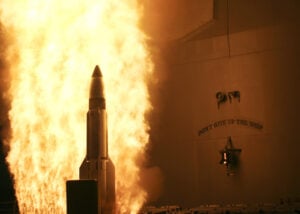
Directed energy anti-satellite weapons for the future. (Lockheed Martin)
WASHINGTON: For months, top officials at the Defense Department have been working toward declassifying the existence of a secret space weapon program and providing a real-world demonstration of its capabilities, Breaking Defense has learned.
The effort — which sources say is being championed by Gen. John Hyten, the vice-chairman of the joint chiefs of staff — is close enough to completion that there was a belief the anti-satellite technology might have been revealed at this year’s National Space Symposium, which kicks off next week.
However, the crisis in Afghanistan appears to have put that on hold for now. Pulling the trigger on declassifying such a sensitive technology requires concurrence of the Director of National Intelligence, Avril Haines, and a thumbs up from President Joe Biden, sources explain; with all arms of the national security apparatus pointed towards Kabul, that is almost certainly not going to happen next week. And until POTUS says yes, nothing is for certain, of course.
READ A FOLLOW-UP PIECE TO THIS STORY HERE.
The system in question long has been cloaked in the blackest of black secrecy veils — developed as a so-called Special Access Program known only to a very few, very senior US government leaders. While exactly what capability could be unveiled is unclear, insiders say the reveal is likely to include a real-world demonstration of an active defense capability to degrade or destroy a target satellite and/or spacecraft.
At least, that is what has been on the table since last year — when officials in the Trump administration viewed revealing the technology as a capstone to the creation of Space Command and Space Force. The plan apparently had been to announce it at the 2020 Space Symposium, which was cancelled due to the COVID-19 pandemic; the arrival of the Biden administration also led to a reevaluation of moving forward with the reveal.
Expert speculation on what could be used for the demonstration ranges from a terrestrially-based mobile laser used for blinding adversary reconnaissance sats to on-board, proximity triggered radio-frequency jammers on certain military satellites, to a high-powered microwave system that can zap electronics carried on maneuverable bodyguard satellites. However, experts and former officials interviewed by Breaking Defense say it probably does not involve a ground-based kinetic interceptor, a capability the US already demonstrated in the 2008 Burnt Frost satellite shoot-down.
Requests for comment to the offices of Hyten, Haines, and SPACECOM were not returned by deadline.
Many military space leaders believe that Space Force and Space Command must publicly demonstrate to Moscow and Beijing not just an ability to take out any space-based counterspace systems they may be developing or deploying, but also to attack the satellites they, like the US, rely upon for communications, positioning, navigation and timing (PNT), and intelligence, surveillance and reconnaissance (ISR).
Notably, the second-in-command of the Space Force recently foreshadowed movement in the long-running debate about declassification of all things related to national security space — a multifaceted and complex debate which has pitted advocates against upholders of the traditional culture of secrecy within DoD and the Intelligence Community.
“It is absolutely a true problem,” Gen. DT Thompson, deputy Space Force commander, responded to a question about over-classification during a July 28 Mitchell Institute event. “I wish we owned our own destiny in that regard, but we don’t — it’s part of a broader activity and we just have to work through that. What I will say is, I think we’re on the verge of a couple of significant steps.”
The Transparency Dilemma
In fact, Thompson’s comments represented only one of several comments, quietly dropped in speeches or interviews, from top military space officials pushing for declassification of high-end systems, following several years of a steadily intensifying drumbeat on the issue. A who’s-who list of top officers, DoD civilian leaders, and key members of Congress have for years been arguing that over-classification is harming the ability to convey the growing threat of foreign counterspace to lawmakers, the public and allied/partner nations — as well as the ability to cooperate with industry and foreign partners to mitigate those threats.

Gen. John Hyten
Sources say that Hyten remains the biggest proponent of a new, declassified demonstration of counterspace capabilities. (And for this reason, there is some rationale to speculate that any announcement would come before he retires in November.)
For years, Hyten has argued that it is impossible to deter adversaries with invisible weapons, and he has taken the lead in calling for space systems to be declassified at a more rapid pace than some traditionalists find comfortable.
“In space, we over-classify everything,” Hyten told the National Security Space Association (NSSA) on Jan. 22. “Deterrence does not happen in the classified world. Deterrence does not happen in the black; deterrence happens in the white.”
Further, Hyten, Chief of Space Operations Gen. Jay Raymond, and Space Command Commander Gen. Jim Dickinson all have asserted that offensive space weapons are a necessary part of that deterrent.
There is also precedent for using conferences to unveil black programs. In 2014, Gen. William Shelton, the then-head of Air Force Space Command, casually unveiled the existence of the Geosynchronous Space Situational Awareness Program (GSSAP) satellites in the middle of a presentation.
But while there is broad consensus among DoD space leadership on the need for declassification, there is fierce debate about what actually should be brought out from behind the onyx curtain of mega-secrecy (in Air Force slang, often called “The Green Door”.)” The National Reconnaissance Office, for example, has long been loath to reveal much of anything about its spy satellites — with officials even attempting to slow-roll a 2018 Hyten policy lifting restrictions on access to basic orbital data about national security satellites.
The central dilemma isn’t hard to understand, but the devil is in the details of solving it.
“We need to take a very hard look at what capabilities we keep concealed, as in our, quote, ‘ace-in-the-hole’ capabilities, if you will, that we would only use in an actual conflict to ensure we maintain the military overmatch we would need to ensure victory, without allowing the enemy to devise ways to defeat that particular capability by having advance knowledge of it,” Matt Donovan, undersecretary of the Air Force under the Trump administration, said in a July 10 Mitchell Institute podcast.
“But what we would really like to do … is prevent that conflict from happening in the first place, by convincing the enemy that they cannot win in a conflict, that the costs of entering into a conflict would be so high to them they don’t start it to begin with; that is the essence of deterrence,” said Donovan, who now heads Mitchell’s Spacepower Advantage Research Center. “So, the problem with only having ‘ace-in-the-hole’ capabilities is they do nothing for deterrence.”
There are also a number of experts who believe that whatever decisions are made, the march of technology guarantees there soon will be no possible way to keep US satellites, or actions on the ground, secret.
“My overall perspective is that a fully transparent world is coming — and no government policy is going to stop it. So, the US — like other governments who are based in the rule of law, respect privacy and protect civil liberties — should not fight that inevitable outcome,” said Robert Cardillo, who spent many years in the Intelligence Community, and recently became board chairman of Planet Federal.
Not so fast, argued another former DoD space official, because the deterrence value actually depends on exactly what kind of weapon system is being discussed.
“Did you conceive of the capability with the idea that you would reveal it? Because if you didn’t, you shouldn’t be revealing it now, or you should really think hard before revealing it,” the source said. “We need to design things that can be that can be revealed without eliminating their effectiveness, and without causing escalation. That’s Step A.”
Military leaders “always want to argue about Step C, instead of doing the intellectual exercise of Step A first,” the former DoD official added.
Another source similarly opined: “The declassification thing is a disaster. … The genesis is supposedly for deterrence — but those doing it lack basic understandings of deterrence. It’s a f***ing shitshow.”
Deterrence — It’s Complicated
To be fair to decision-makers, there have been countless studies, essays and books written about deterrence theory, including about space deterrence, and there are just as many opinions as there are authors.
There is a general consensus among Western experts that strategists and policy-makers must be careful in attempting to map space deterrence to traditional Cold War nuclear deterrence. While there are some similarities — and importantly some strong linkages between nuclear stability and the use of space — there are too many differences, not the least of which is the fact that losing a few satellites is not parallel to losing a few cities.
The second area of general consensus is that deterring adversaries from attacking US space systems (military and commercial) will depend on the adversary. China is not Russia, or even the Soviet Union. Furthermore, because of economic entanglements, US relations with China are way more complicated than they ever were with the USSR.
A third and final point of agreement: space deterrence in particular is hard, and will require an entire tool box ranging from multi-domain military capabilities, to diplomatic actions such as signaling and building international consensus about threatening activities, to economic levers such as punitive sanctions.
Choosing what tools to use when, however, is where agreement breaks down.
This is particularly true with regard to China, which up to now has not had as great a military reliance on space as the US — and more importantly does not have a strategic view shaped by Cold War superpower nuclear deterrence theory (i.e. “mutually assured destruction.”) Following Beijing’s 2007 anti-satellite (ASAT) test, there have been oodles of studies inside and outside DoD specifically on deterring China in space, many of which come to the same conclusion, if not always the same solutions: it’s hard.
For example, RAND’s recent “Tailoring Deterrence for China in Space” has snagged a lot of DoD eyeballs. It highlights the obstacles to success, and argues that DoD might need a “demonstration of capabilities (emphasis ours) that would compromise the PLA’s space systems, perhaps through enhanced U.S. cyber hacking, spoofing, jamming or other dazzling capabilities against China, but could also include kinetic options as well.” But, it warns, any such Space Force activities must be “carefully calibrated.”
A 2008 Council on Foreign Relations report, “China, Space Weapons and U.S. Security,” based on meetings of an advisory board that included active and former DoD and IC officials plus think tank experts (including this author), came to essentially the same conclusions as RAND regarding the difficulties involved. It, too, recommended deployment of offensive ASAT weapons, but limited to non-kinetic systems with reversible effects — and coupling this with robust diplomatic initiatives to set norms and/or establish a treaty to ban debris-creating ASATs.

The USS Lake Erie (CG 70) launches a Standard Missile-3 at a non-functioning National Reconnaissance Office satellite as it traveled in space at more than 17,000 mph over the Pacific Ocean on Feb. 20, 2008.
Active Messaging
The US military tends to focus on two distinct types of deterrence, including in the space domain: reducing the vulnerability of US capabilities (i.e. building resilience/reconstitution/passive protections) and punitive military responses via offensive strikes.
In the blurry middle between those two is “active defense.” The key Joint Publication outlining milspace operations, JP 3-14 Space Operations (updated in October 2020), defines active and passive “space defense” (not to be confused with plain old active and passive defense as elsewhere, and differently, defined in the “DoD Dictionary of Military and Associated Terms”.) It says:
Active space defense consists of actions taken to neutralize imminent space control threats to friendly space forces and space capabilities.
“The purpose of the US offensive counterspace capability has nothing to do with space. It has to do with protecting US forces on the ground,” a former senior DoD official attempted to explain. “The purpose of US resilience is to continue to provide mission capability to forces on the ground. And the purpose of active in-space defense is to protect satellites in space. So three different things here.”
And the terminology used by the US in declassifying a weapon will matter, because it affects the messaging, and how that message is received by the US public, allies/partners, and the broader international community. Indeed, these distinctions are often deliberately muddied by space weapons advocates out of concerns about US public perception, which to this day remains largely leery of space weaponization.
For example, one expert worried about the declassification plan’s potential negative ramifications for US efforts to set global norms of behavior for space — especially if there is an accompanying demonstration of capability akin to 2008’s Burnt Frost. (Ironically, DoD just last month issued its first-ever policy on space norms.)
In Burnt Frost, DoD took down a failed satellite that was tumbling back to Earth, using a modified Standard Missile-3 interceptor. The George W. Bush administration argued at the time that the move was necessary to avoid the potential spread of toxic rocket fuel, convincing almost no one.
Instead, the shoot-down spurred criticism inside and outside the US, including in allied nations, with observers perceiving it as a direct response to China’s ASAT test the year before. Critics argued that it was at best was an unnecessary demonstration US ASAT capability that until then was known but implicit; and at worst provocative, confirming long-standing allegations by Beijing (and Moscow) that US missile defenses were also designed as ASATs.
“The response of an offensive ASAT to a Chinese ASAT is not going to make them stop doing it,” one former government official said. “If you want to demonstrate a response, demonstrate … an unexpected maneuver or a LEO satellite that they had never seen before. But the fact that the response was, ‘well, I can shoot down satellites too,’ that doesn’t do shit about stopping them from shooting mine down.”
And even today, one concerned insider said, “A lot of the DoD work on space control ‘strategic messaging’ isn’t backed up by any real strategy, or red-teaming.”






















